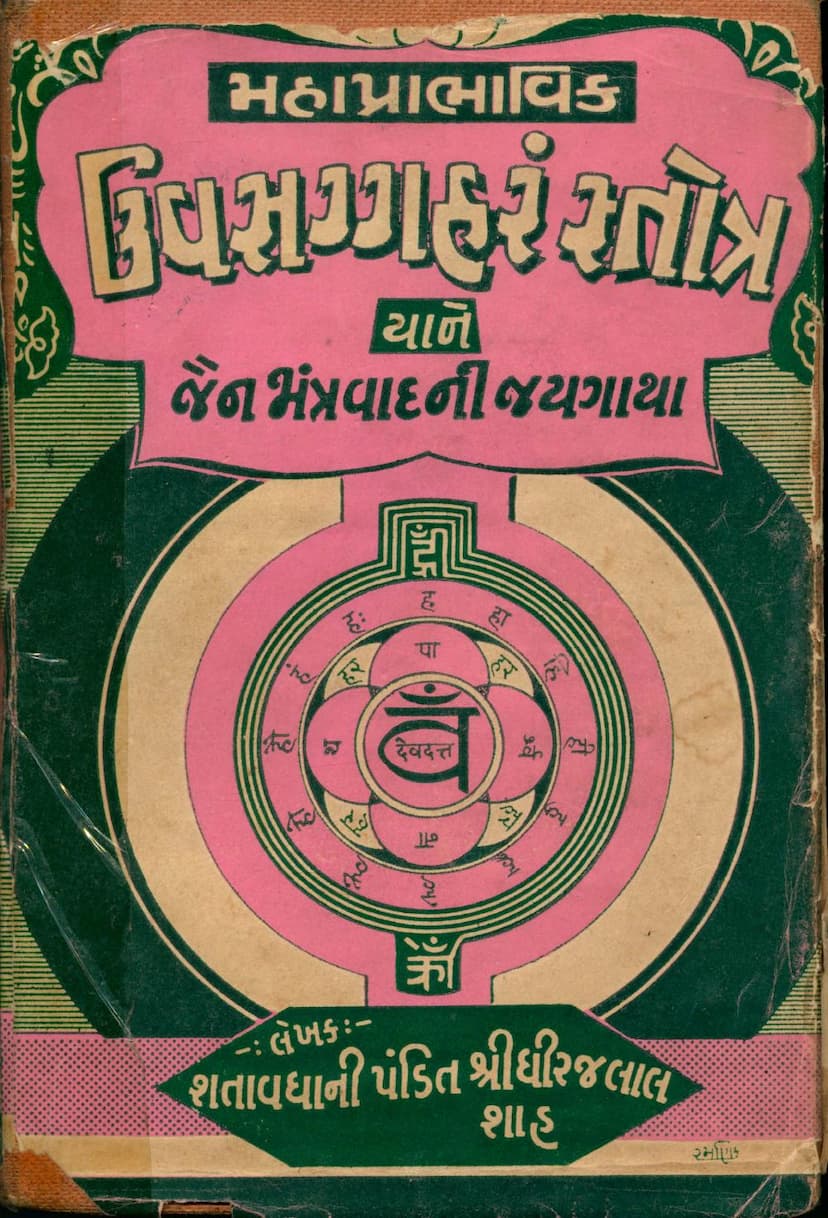Mahaprabhavik Uvasaggaharam Stotra Yane Jain Mantravadni Jaygatha
Added to library: September 2, 2025

Summary
This is a comprehensive summary of the Jain text "Mahaprabhavik Uvasaggaharam Stotra Yane Jain Mantravadni Jaygatha" by Dhirajlal Tokarshi Shah, published by Jain Sahitya Prakashan Mandir.
Book Title: Mahaprabhavik Uvasaggaharam Stotra Yane Jain Mantravadni Jaygatha (The Greatly Efficacious Uvasaggaharam Stotra, or The Victory Chronicle of Jain Mantricism)
Author: Shatavadhani Pandit Shri Dhirajlal Tokarshi Shah (also known by various titles indicating his scholarship and mastery in multiple fields).
Publisher: Jain Sahitya Prakashan Mandir, Mumbai.
Overall Summary:
This book is a deep and extensive exploration of the Uvasaggaharam Stotra, a powerful Jain devotional hymn attributed to Lord Parshvanath. The author, Dhirajlal Tokarshi Shah, a highly accomplished scholar and devout follower, presents this work as a "Victory Chronicle of Jain Mantricism," highlighting the efficacy of the Stotra in warding off afflictions (upasarga) and fulfilling desires through its associated mantras and yantras (mystical diagrams).
The book delves into various aspects of the Stotra, providing a rich tapestry of Jain philosophy, history, and practice. It aims to educate and inspire the reader by explaining the origins, significance, and practical application of this revered hymn.
Key Aspects Covered in the Book:
-
Introduction and Significance: The book begins with a warm welcome and emphasizes the importance of the Stotra, highlighting its power to overcome obstacles and bring prosperity. It stresses that the efficacy of mantras and yantras remains relevant even in the current era.
-
Lord Parshvanath: A significant portion of the book is dedicated to the life and teachings of Lord Parshvanath, the 23rd Tirthankara. It provides historical and biographical details, including his birth, marriage, renunciation, penance, attainment of Kevala Jnana (omniscience), and Nirvana. It clarifies his historical context, distinguishing him from other Parshvanath figures and referencing scholarly opinions on his existence. The book also details his attributes, particularly why he is called "Purushadaniya" (worthy of worship by great men).
-
Mantricism and Yantras in Jainism: The book extensively discusses the role and importance of mantras, yantras, and their practices within Jainism. It explains the concept of mantric power, its proper use, and the principles behind yantra creation and worship. It highlights that while physical rituals are important, the true efficacy lies in devotion and pure intent.
-
Detailed Analysis of the Uvasaggaharam Stotra:
- Origin: The book traces the origin of the Stotra, linking it to the efforts of a great Acharya, possibly Bhadrabahuswami, to alleviate a widespread epidemic.
- Structure and Variations: It discusses the different versions of the Stotra, noting variations in the number of verses (from 5 to 27).
- Verse-by-Verse Explanation: Each of the original five verses is meticulously explained, providing their Sanskrit transliteration, Gujarati meaning, and philosophical insights.
- Mantras and Yantras: For each verse, the book details associated mantras and yantras, explaining their specific purposes, such as warding off illnesses, attracting wealth, overcoming obstacles, and bringing peace. It includes intricate descriptions and illustrations (mentioned in the text, though not provided in the transcription) of these mystical diagrams.
-
Personal Experiences and Testimonials: The author shares personal anecdotes and experiences that illustrate the power of the Stotra and associated practices. These include instances of overcoming severe illness, resolving financial difficulties, and experiencing divine intervention, reinforcing the belief in the Stotra's miraculous efficacy.
-
Praise for Lord Parshvanath: The book includes numerous "Vandanas" (salutations) from various individuals and organizations, each praising a different attribute or aspect of Lord Parshvanath, further emphasizing his greatness and the devotion he inspires.
-
List of Important Jain Tirthas: A comprehensive list of prominent Jain pilgrimage sites related to Lord Parshvanath is provided, offering geographical and historical context for these sacred places.
-
Mantra Siddhi: The book discusses the possibility and process of achieving mantra siddhi (perfection in mantra recitation), emphasizing the need for purity of mind, body, discipline, and adherence to tradition and guidance from a Guru. It also touches upon the potential for misuse of such powers, cautioning against selfish motives.
-
Scholarly Approach: The author's meticulous research is evident in his referencing of various Jain scriptures (Agamas), commentaries, and historical texts. He also engages with scholarly opinions, particularly regarding the historical dating of Lord Parshvanath and the debate surrounding the authorship of the Stotra.
-
Dedication: The book is dedicated to Muni Shri Yashovijayji Maharaj, acknowledging his significant contributions to Jain literature and culture.
In essence, this book serves as a comprehensive guide for Jain devotees seeking to understand, practice, and benefit from the Uvasaggaharam Stotra. It combines historical accounts, philosophical explanations, practical instructions for mantra and yantra worship, and inspiring personal testimonies, all centered around the profound devotion to Lord Parshvanath.